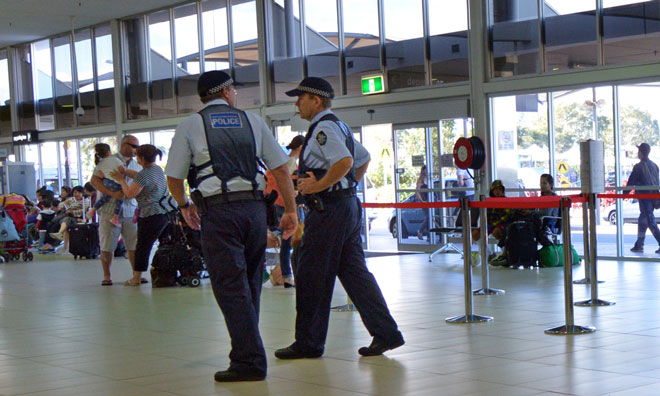What will you do in a time of self-evacuation?
- Like
- Digg
- Del
- Tumblr
- VKontakte
- Buffer
- Love This
- Odnoklassniki
- Meneame
- Blogger
- Amazon
- Yahoo Mail
- Gmail
- AOL
- Newsvine
- HackerNews
- Evernote
- MySpace
- Mail.ru
- Viadeo
- Line
- Comments
- Yummly
- SMS
- Viber
- Telegram
- Subscribe
- Skype
- Facebook Messenger
- Kakao
- LiveJournal
- Yammer
- Edgar
- Fintel
- Mix
- Instapaper
- Copy Link
Posted: 31 May 2017 | Neville Hay | No comments yet
In the case of an attack, it is difficult to have one set policy applicable to each and every airport. This may sound obvious. Neville Hay explains further…


Not every airport within each State across the globe has a dedicated police presence, the number of police officers available will vary from airport to airport. Some will be passing patrols; some will only visit in response to an incident, others will have a 24/7 presence. Policing can be a combination of overt or covert tactics, their presence is to act as a visual deterrent, carry out proactive as well as reactive policing and play its part in any airport emergency. Their role is to act as a deterrent, prevent, protect, pursue individuals involved in terrorism or serious organised crime and assist to prepare all agencies in a time of crisis and the recovery from an event.
It must be remembered these events are few and far between in terms of the global network of airports, the travelling public and airlines. Although the number of incidents is low we have seen a constant threat to the industry that is not going to go away. The threat is always changing in terms of the methodology of the attack, the outcome will be the same, death, destruction and publicity, aviation is and will remain an attractive target for attacks being carried out by a lone actor or a team of individuals.
Tactics vary from knives, vehicles, firearms, explosives and or a combination of both as with the marauding attacks that have been seen. With all attacks there is planning and preparation, there will be an element of hostile reconnaissance and this is where the individual or individuals become vulnerable to detection.
The threat is always changing in terms of the methodology of the attack.
Airport security managers experience, skill and knowledge will vary in terms of operational, tactical and strategic thinking around security and there is the influence and balance of security and facilitation to factor in. Some managers will have a dual role and may be the figure head for leading security whilst employed in other areas. These are all balances airports will have to deal with and as said before will vary from the size of the airport. Just because an airport is small doesn’t mean that those involved in terrorism or serious organised crime will not pass through the airport, they may well use the airport as they know there is little means of detection and so make use of a route to travel onto other locations.
Terrorist and criminals in my opinion operate in the same way they just have different agendas. A security manager has to deal with the security of the airport knowing that the risk of an attack is low in terms of its frequency but high in terms of the impact and outcome. When added to the balance of business, profit and cost it is a difficult task to say the least. Unfortunately, if one cuts corners and fails to take into account history then one has to accept if the unfortunate happens at their airport they will wish they had implemented a security culture, one that takes into account the 3 P’s of Protect, Prevent and Prepare. Making use of the available resources, doing everything possible to reduce the risk and threat is being able to confirm and provide a rationale as to why a particular decision was taken.
One cannot stop terrorism or serious organised crime, it is how one manages and mitigates the risk with the available resource and revenue at their disposal. In my opinion this is why security should be looked upon as everyone’s responsibility, not just entities but every employed person. There has to be a holistic approach, shared resources, shared technology and education, a change in the mind set. Included in this is security by design for any new build and likewise for any expansion. There needs to be involvement from the environment in terms of the people working at the airport.
Some airports have their own in house security whilst others employ a security provider. There have been many debates centred around what is best, in house security or a security provider. Whether in house or security provider they should be well trained, able to operate and deal effectively and efficiently with all security issues within the environment.
January of this year witnessed a mass self-evacuation at Fort Lauderdale airport when Esteban Santiago, 26, from New Jersey, shot dead fellow passengers in the baggage reclaim area. Mass evacuation and more so self-evacuation will happen in any event where people are in fear, whether through terrorism, crime or a fire, people will think about their own safety, it is in our DNA, our make up to flee or fight.
So how can the airport community come together? How do they integrate? Who has responsibility and who takes control? How do they communicate and how do they train? There will never be enough resource to deal with events beyond normal day to day business. Here lies the issue and the questions? The biggest question being, “Am I prepared?”
This is not a question just for the police commanders or the airport security manager, it should be a question for everyone working at an airport each employer should ask and ensure their workforce is prepared to assist in a time of need.
But who coordinates this and who will assist with the education of employees when some may have the opinion or attitude that it will not happen here, so why do I need to? It is a fair point, but then tell that to the security managers who have experienced the unthinkable happening and were glad they had planned, prepared and reviewed processes and procedures. Not forgetting after the event the independent enquiry will often follow, only then are you going to wish you had planned, prepared and invested.
Security of the airport and reacting to an unplanned event beyond that of day to day business is the challenge for any airports no matter what the size. The cost of security and the ever changing landscape from the threat of terrorism begs the question how well prepared are airports? Do airport security managers understand and acknowledge the threat that it could happen to them or is there still a mind-set of, that it would not happen at their airport.
No matter what the feeling is, even circumstances not involving terrorism how well prepared are our airports. Take for example a fire evacuation of an airport, it may be controlled but what happens when panic sets in and there is self-evacuation. How well prepared is the airport to take control.
Florida saw an attack by an individual who flew into the airport, collected his bags from the carousel and armed himself before going onto shoot and kill 5 people. A self-evacuation took place, as was the same at LAX when the TSA officer was shot. In these incidents things happen quickly and when things go wrong they can go wrong just as quick, making it difficult to play catch up.
If one looks at TV footage of the Florida incident it is clear to see employees and uniformed security walking on the apron some in groups, some sitting on appliances, there appeared a lack of coordination and there did not appear to have been any action being taken by those individuals, more than likely because they had not been told or educated in assisting with a mass evacuation. The issue here is that the public’s expectations are different to the outcomes.
They will ask the question why as an airport employee you were not in a position to help.
Events such as these always teach us, this is not a criticism, it is an observation. If we put it in very simple terms, when an airport employee walks around the airport they will be stopped daily by passengers and asked simple questions: Where is the check in desk? Where is the bus terminal? Where is the taxi rank? Where are the toilets? These are all simple questions.
Now with technology and airport apps, airport employees can answer the question instead of saying I am sorry I don’t know avoiding the follow up question of, why don’t you, you work here don’t you? I am sure this will resonate with everyone working at an airport.
The Fort Lauderdale airport incident took approximately 70 – 90secs the aftermath continued for over 11hrs.
So let’s take that a step further, lets educate the staff that work in the airport, lets provide them with a communications platform so in a time of crisis they can assist and respond. The airport security manager will increase his resource by those employed, they know the environment better than anyone and will know exactly what is required. Each tenant will play their part, each manager will carry out briefings and questions to staff on a regular basis to ensure staff are aware of their responsibility should they be called upon. There is strength in a community. When people work together, they strive together to bring about unity, it breeds power, it breeds a sense of responsibility and achievement, it takes a community to protect a community. Think of these employees as the shop keeper begets life boat reservist, fire reservist, in a time of need they change from one to the other.
Whether one works in the airport or the financial district of a city the power of the community is all around. We just have to educate them and provide a means to communicate. I have been privilege to be involved in both through my work developing community engagement and using technology developed to assist the community and security allowing synergy and strength through partnership working.
The Fort Lauderdale airport incident took approximately 70 – 90secs the aftermath continued for over 11hrs. The Westminster Bridge attack and the subsequent stabbing of PC Keith Palmer took 82sec from start to finish. The first 999 call received some 59 secs into the incident. In all incidents it is the public, the individuals that work in the area or the passing public that respond, they are the first responders, the emergency services respond immediately but will not be on site in the initial stages. Learning from these events airport security managers need to look at responses to incidents, making use of the available resource the airport community to assist in a time of crisis and evacuation, by planning and preparing will assist preventing and protecting the environment and mitigate the risk and threat and subsequently provide for a better outcome.
Related topics
Accidents and incidents, Airport crisis management, Security, Terrorist attacks

















